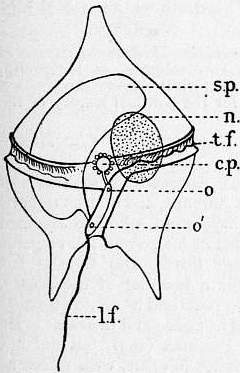|
Nioella Ostreopsis
''Nioella ostreopsis'' is a Gram-negative, short-rod-shaped, strictly aerobic and non-motile bacterium in the genus of ''Nioella'' which has been isolated from the dinoflagellate ''Ostreopsis lenticularis Ostreopsis lenticularis is a species of dinoflagellate of the Family (biology), family Ostreopsidaceae described in 1981 by Yasuwo Fukuyo. Distribution This species is endemic to Tahiti. References * Fukuyo Y. 1981. Taxonomical study on benthi ...''. References Rhodobacteraceae Bacteria described in 2020 {{Rhodobacterales-stub ... [...More Info...] [...Related Items...] OR: [Wikipedia] [Google] [Baidu] |
Gram-negative
Gram-negative bacteria are bacteria that do not retain the crystal violet stain used in the Gram staining method of bacterial differentiation. They are characterized by their cell envelopes, which are composed of a thin peptidoglycan cell wall sandwiched between an inner cytoplasmic cell membrane and a bacterial outer membrane. Gram-negative bacteria are found in virtually all environments on Earth that support life. The gram-negative bacteria include the model organism ''Escherichia coli'', as well as many pathogenic bacteria, such as '' Pseudomonas aeruginosa'', '' Chlamydia trachomatis'', and '' Yersinia pestis''. They are a significant medical challenge as their outer membrane protects them from many antibiotics (including penicillin), detergents that would normally damage the inner cell membrane, and lysozyme, an antimicrobial enzyme produced by animals that forms part of the innate immune system. Additionally, the outer leaflet of this membrane comprises a complex ... [...More Info...] [...Related Items...] OR: [Wikipedia] [Google] [Baidu] |
Rod-shaped
A bacillus (), also called a bacilliform bacterium or often just a rod (when the context makes the sense clear), is a rod-shaped bacterium or archaeon. Bacilli are found in many different taxonomic groups of bacteria. However, the name '' Bacillus'', capitalized and italicized, refers to a specific genus of bacteria. The name Bacilli, capitalized but not italicized, can also refer to a less specific taxonomic group of bacteria that includes two orders, one of which contains the genus ''Bacillus''. When the word is formatted with lowercase and not italicized, 'bacillus', it will most likely be referring to shape and not to the genus at all. Bacilliform bacteria are also often simply called rods when the bacteriologic context is clear. Bacilli usually divide in the same plane and are solitary, but can combine to form diplobacilli, streptobacilli, and palisades. * Diplobacilli: Two bacilli arranged side by side with each other. * Streptobacilli: Bacilli arranged in chains. * Cocc ... [...More Info...] [...Related Items...] OR: [Wikipedia] [Google] [Baidu] |
Aerobic Organism
{{disambiguation ...
Aerobic means "requiring air," in which "air" usually means oxygen. Aerobic may also refer to * Aerobic exercise, prolonged exercise of moderate intensity * Aerobics, a form of aerobic exercise * Aerobic respiration, the aerobic process of cellular respiration * Aerobic organism, a living thing with an oxygen-based metabolism See also * Anaerobic (other) Anaerobic means "living, active, occurring, or existing in the absence of free oxygen", as opposed to aerobic which means "living, active, or occurring only in the presence of oxygen." Anaerobic may also refer to: * Anaerobic adhesive, a bonding a ... [...More Info...] [...Related Items...] OR: [Wikipedia] [Google] [Baidu] |
Dinoflagellate
The dinoflagellates (Greek δῖνος ''dinos'' "whirling" and Latin ''flagellum'' "whip, scourge") are a monophyletic group of single-celled eukaryotes constituting the phylum Dinoflagellata and are usually considered algae. Dinoflagellates are mostly marine plankton, but they also are common in freshwater habitats. Their populations vary with sea surface temperature, salinity, and depth. Many dinoflagellates are photosynthetic, but a large fraction of these are in fact mixotrophic, combining photosynthesis with ingestion of prey ( phagotrophy and myzocytosis). In terms of number of species, dinoflagellates are one of the largest groups of marine eukaryotes, although substantially smaller than diatoms. Some species are endosymbionts of marine animals and play an important part in the biology of coral reefs. Other dinoflagellates are unpigmented predators on other protozoa, and a few forms are parasitic (for example, '' Oodinium'' and '' Pfiesteria''). Some dinoflagell ... [...More Info...] [...Related Items...] OR: [Wikipedia] [Google] [Baidu] |
Ostreopsis Lenticularis
Ostreopsis lenticularis is a species of dinoflagellate of the Family (biology), family Ostreopsidaceae described in 1981 by Yasuwo Fukuyo. Distribution This species is endemic to Tahiti. References * Fukuyo Y. 1981. Taxonomical study on benthic dinoflagellates collected in coral reefs. Bull. Jap. Soc. Sci. Fish. 47: 967-978 * Gómez, F. (2005). A list of free-living dinoflagellate species in the world's oceans. Acta Bot. Croat. 64(1): 129-212 * Streftaris, N.; Zenetos, A.; Papathanassiou, E. (2005). Globalisation in marine ecosystems: the story of non-indigenous marine species across European seas. Oceanogry and Marine Biology: an Annual Review. 43: 419-453 * Steidinger, K. A., M. A. Faust, and D. U. Hernández-Becerril. 2009. Dinoflagellates (Dinoflagellata) of the Gulf of Mexico, Pp. 131–154 in Felder, D.L. and D.K. Camp (eds.), Gulf of Mexico–Origins, Waters, and Biota. Biodiversity. Texas A&M Press, college * Chang, F.H.; Charleston, W.A.G.; McKenna, P.B.; Clowes, ... [...More Info...] [...Related Items...] OR: [Wikipedia] [Google] [Baidu] |
Rhodobacteraceae
The Rhodobacteraceae are a family of Pseudomonadota in the order Rhodobacterales within the alpha subgroup.See the NCBIbr>webpage on Rhodobacteraceae Data extracted from the Like all Pseudomonadota, they are gram-negative. It contains chemoorganotrophs and photoheterotrophs bacteria. Many occur in aquatic habitats. Genera Accepted Genera The following genera have been effectively and validly published: * ''Acidimangrovimonas'' Ren ''et al''. 2019 * ''Actibacterium'' Lucena ''et al''. 2012 * '' Aestuariibius'' Park ''et al''. 2018 * '' Aestuariicoccus'' Feng ''et al''. 2018 * '' Aestuariihabitans'' Yoon ''et al''. 2014 * '' Aestuariivita'' Park ''et al''. 2014 * ''Aestuarium'' Yu ''et al''. 2019 * ''Agaricicola'' Chu ''et al''. 2010 * '' Albibacillus'' Hördt ''et al''. 2020 * ''Albidovulum'' Albuquerque ''et al''. 2003 * '' Albimonas'' Lim ''et al''. 2008 * ''Albirhodobacter'' Nupur ''et al''. 2015 * ''Aliiroseovarius'' Park ''et al''. 2015 * ''Aliishimia'' Kim ''et al'' ... [...More Info...] [...Related Items...] OR: [Wikipedia] [Google] [Baidu] |

